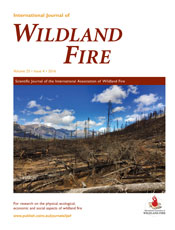
International Journal of Wildland Fire
Volume 25 Number 4 2016
WF14193Wildfire survival plans in theory and practice
This paper examines how wildfire preparedness differs between residents with a mental, written or no survival plan, and the implications of plans having been discussed and practised with others. It highlights why explicit and consistent official preparedness advice is important for risk communication and communities at risk.
WF15051A value- and expectancy-based approach to understanding residents’ intended response to a wildfire threat
This study examines personal factors affecting residents’ intended response to a wildfire alert. Those who intend to leave on awareness of a fire threat differ from those who do not in the value attached to different wildfire outcomes and perceived likelihood of achieving them through defence vs evacuation.
WF15128The net benefits of human-ignited wildfire forecasting: the case of tribal land units in the United States
Wildfire managers devote scarce resources towards reducing the overall costs and losses associated with human-ignited wildfires. Resource use could be reduced if decision-makers knew when future fires could ignite. We found positive net economic benefits of forecasting incendiary and non-incendiary human-ignited wildfires on tribal lands in the US.
WF15108Global fire size distribution: from power law to log-normal
Fire size distribution is expected to follow a power-law distribution. Here, we show that instead, log-normal emerges as a suitable option to fit fire size distribution, with only two out of eight areas where fire size distribution can be adequately described by a power law.
WF150391984–2010 trends in fire burn severity and area for the conterminous US
We examined burn severity and area between 1984 and 2010 within the conterminous United States using MTBS data and found that burn severity and area did not change substantially within most of the assessed vegetation groupings.
WF15111Ensemble lightning prediction models for the province of Alberta, Canada
Lightning-caused wildfires in remote areas have large suppression costs and a greater chance of escaping initial attack when compared to human-caused wildfires. We present an ensemble forecasting approach based on 6-h and 24-h random forest models. The models provide a significant improvement in lightning prediction for Alberta’s forested areas, achieving hit rates of up to 85%.
WF15048Altered mixed-severity fire regime has homogenised montane forests of Jasper National Park
Dendrochronological data from 29 montane sites in Jasper National Park provided evidence of a mixed-severity fire regime. Historical fires leaving scars or even-aged cohorts burned between 1646 and 1905. In the absence of fires after 1905, forests have matured simultaneously, homogenising the landscape. Proactive management to counter fire suppression effects is justified.
WF15068Repeatability of free-burning fire experiments using heterogeneous forest fuel beds in a combustion wind tunnel
This study explores the implications of using heterogeneous fuel beds in combustion wind tunnel experiments. The overall variability in rate of spread was low in comparison to the effects of the experimental treatments, so subsequent experiments using heterogeneous fuel will not require large numbers of replicates to detect effects of treatments.
WF15103Propagation probability and spread rates of self-sustained smouldering fires under controlled moisture content and bulk density conditions
We coupled laboratory-scale observations of smouldering fires with statistical models to analyse the self-sustained propagation and spread rates for horizontal distances, which have not been researched before. Our findings enable the effects of peat moisture and density conditions on smouldering propagation dynamics to be understood.
WF15103 Abstract | WF15103 Full Text | WF15103PDF (345 KB) | WF15103Supplementary Material (240 KB) Open Access Article
WF15047A quantitative assessment of shoot flammability for 60 tree and shrub species supports rankings based on expert opinion
We quantify the shoot flammability of 60 New Zealand tree and shrub species, including 10 exotic species. Our results corroborate a qualitative assessment of NZ plant flammability based on expert opinion. We advise fire managers on low-flammability species suitable for green firebreaks and identify highly flammable indigenous and exotic species.
WF15047 Abstract | WF15047 Full Text | WF15047PDF (322 KB) | WF15047Supplementary Material (200 KB) Open Access Article
WF15078Effects of heat on dehiscence and germination in Eucalyptus globulus Labill.
Different combinations of temperature and exposure time were used to test the effect of heat on the dehiscence of capsules and on the germination of seeds of Eucalyptus globulus. This study shows that seed shed is caused by capsule desiccation but not directly by heat, and that capsules provide effective protection to seeds for specific temperature–time combinations.
WF15163The ability of winter grazing to reduce wildfire size and fire-induced plant mortality was not demonstrated: a comment on Davies et al. (2015)
This commentary highlights the scientific shortcomings in the paper by Davies et al. (2015). The study has methodological errors, has insufficient data to support the authors’ conclusions and lacks thoroughness in their discussion.
WF15209Winter grazing decreases the probability of fire-induced mortality of bunchgrasses and may reduce wildfire size: a response to Smith et al. (this issue)
Winter grazing decreases the likelihood of large wildfires and fire-induced mortality of native bunchgrasses. Contrary to claims by Smith et al. (2016), our data and prior literature provide strong evidence that grazing reduced the duration of elevated temperatures experienced by bunchgrasses and moderated fire behaviour.



